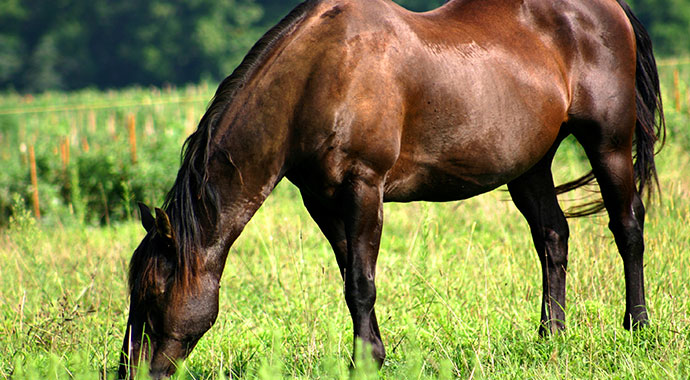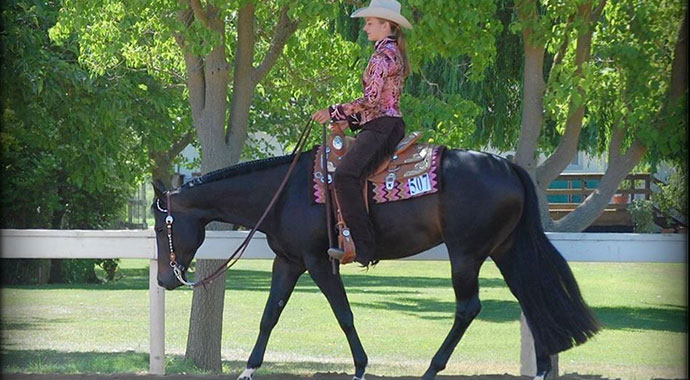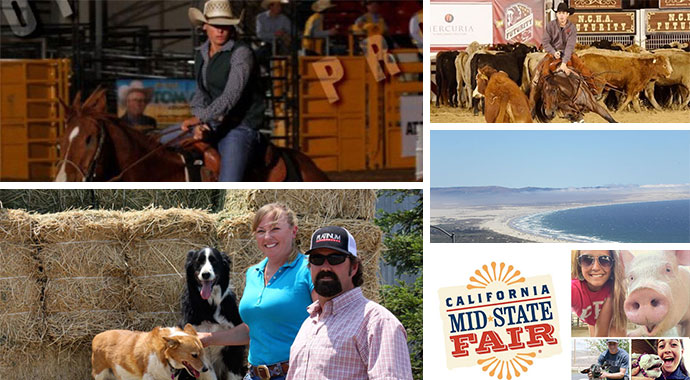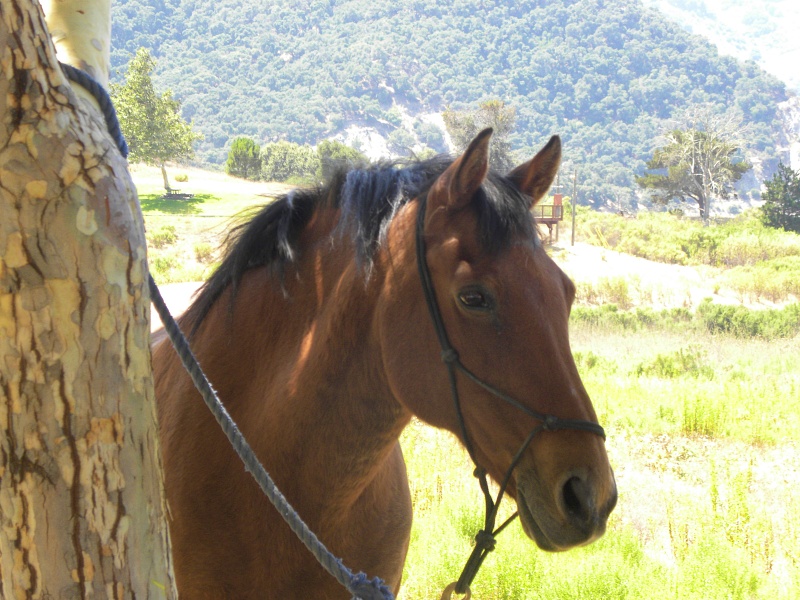Entering the Next Phase…
Most people think of the “Golden Years” as the time to relax and reap the benefits of their many years of hard work. Just as retirement does not come in equal measure for people, neither does retirement for horses. As the economy staggers and creeps forward toward recovery (or not), more and more people are choosing a darker option when their horse’s show career is over or they are irreparably injured. The Golden Years in equine terms may be only a matter of “golden minutes” or hours for some as this choice is made on their behalf. Sadly, for some, retirement may mean a terrifying trip to a Mexican slaughter house and a painful death. And since these horses have no voice in the matter, making the right choice for their continued well-being becomes an even greater responsibility of those to whom they have given such great service.
The term “warehousing” is often used to describe the practice of placing a horse in a stall after their career is over, then simply walking away. While their basic needs are often met, i.e., feed, blanketing, shoeing, etc., socialization and outside stimulus can be absent in many of these chosen environments. As herd animals, horses need to interact with their own species to maintain a healthy and happy emotional balance. Horses who are turned out and stalled alone, without access to any form of socialization, can become severely depressed, which may ultimately impact their physical health and lead to obsessive behavior, such as “rocking” or “weaving,” and “cribbing.”
“Why are you doing this to me?”
There is nothing more heartbreaking to watch than a horse incessantly weaving in their stall, day in and day out. Their expressions are blank and void of any emotion; the spark that was once in their eyes has now been extinguished. If they do lift their heads to look at you, a vacant stare greets you. Their coats, once dazzling with shine, are now a dull mix of unattended hair and errant chunks of mud. Their tails hang limp and knotted…their manes are long, punctuated by tangles and missing tufts of hair where they have rubbed against the walls of their stall. These are horses that have been “warehoused” by their owners; confined to a small pipe stall or similar enclosure with no hope for relief. To the horse, it is nothing short of prison. To the owner, it may be only a matter of convenience and financial necessity.
The Economics….
Retiring a horse with dignity, whether due to age or injury, can be burdensome financially. Most caring horse owners would not willingly choose a life of confinement for their horses, nor would they choose a facility with little or no turnout area. In many instances, it is merely a matter of necessity, economic or otherwise. Horses, however, are not given the same psychological capacity as humans. Thus, they do not comprehend the concept of money. And like many other animals, they have no concept of time. Consequently, it matters little to them what the cost of their leisure years may be. Yet, as sentient beings, they do comprehend feelings of physical and mental pain. On some level, they may very likely be conscious of being abandoned by someone who they once regarded as their trusted companion and caregiver.
“If I Could Speak, I Would Ask You For This……”
The ideal retirement and rehab facility for horses is a balanced mix of in-stall facilities combined with plenty of irrigated pasture for turnout. Land is a rare commodity in the Western States, especially in California, so we have fewer facilities meeting this criteria from which to choose. And while most horse owners would like to opt for a higher grade retirement facility, it is not always feasible to do so because of financial considerations or availability close to home. In most cases, a horse owner will simply make the best of their current circumstances.
East Coast, West Coast …
For contrast, I interviewed two retirement/rehab facilities; one in Lynnville, TN and the other in Paso Robles, CA. And while there are many facilities throughout the United States, I chose these two because of the diversity of services offered at their facilities, the various opinions of their owners, and location. Here is what I learned:
The term “warehousing” may sound a little harsh to some, yet it is not a rare occurrence. Whether it is defined as perpetual confinement without any form of relief, or anything of lesser effect, it may be due to the simple fact that good turnout is less than abundant in many states. Paradigm Farms in Tennessee offers abundant acres of irrigated pasture to its retired residents. “If, [however], a horse is getting a lot of human interaction, such as grooming, hand walking, etc., [and is stabled] at a busy barn where they can watch a lot of activity, many horses handle this just fine.” This is certainly a more attractive alternative to no interaction and no activity whatsoever. And while it may not be ideal in terms of a quality equine retirement, it may simply be a matter of making the best of less than ideal circumstances.
As herd animals, horses that are denied their freedom and confined for long periods of time can become severely depressed, which can be manifested by extreme symptoms of boredom, such as ”rocking” or “weaving.” Melissa Webb, owner of Paradigm Farms, has observed that many of their residents arrive at the facility with such stereotypical behavior, but the cause of such behavior is not always attributable to being stalled for long periods. “Some horses are genetically disposed to being cribbers..they can live outside with a compatible group their entire life and still crib.” Other factors, such as diet and personality, can often times contribute to the development of such chronic behavior. And while confinement to a small space for long periods of time is certainly a major factor, most horses will stop whatever behavior they have acquired once introduced to regular pasture time with other horses.
Retirement or Rehabilitation?
Horses are retired for a variety of reasons, many of which do not relate to the age of the horse. Injuries can often lead to an early retirement as well. This presents yet another dilemma for the horse owner: retirement or rehabilitation? Many facilities offer both levels of service if the market and land costs will sustain it. From an economic perspective, rehabilitation can be far more costly than early retirement. So much depends upon the nature of the injury, the training discipline, estimated length and likelihood of recovery, and the costs involved. Paradigm Farms is home to retirees as young as five and several under the age of ten. “At our farm, more horses are retired due to injury – or nagging issues that won’t go away after an injury – than age.” The average age at Paradigm Farms is 19. Their most elderly resident is 36!
In contrast to the larger retirement population of Paradigm Farms, Los Laureles Equine Therapy Center in Paso Robles, California, is host to a larger number of horses engaged in some form rehabilitation therapy. With 700 acres, four pristine barns, a racetrack and 40 turnout pastures, Los Laureles most certainly has the room to function as a mixed use facility. And it does. Los Laureles offers state of the art therapeutic equipment to aid in the progressive and effective recovery of its residents. The underwater treadmill provides relief to aching joints while building muscles and stamina; the vibrating floor aids in blood circulation and serves as a preventive to chronic lameness. The retired residents benefit greatly from the same modology to maintain their comfort level and quality of life. So, if the senior citizens of Los Laureles are not hanging out in their two acre pastures, they are taking a dip in the underwater treadmill or chilling on the vibrating floor. I could live with that.
And Everything in Between…
For most of us mortals who engage in horse worship, we want only the best possible life for our equine partners, whether they are actively showing or slowing down due to age. The cost of retiring a horse can be high, but there are many facilities throughout the United States that offer a nice menu of choices at a reasonable cost. From top to bottom, there is a very wide range of prices and quality of facilities to choose from, depending upon individual finances, needs of the horse, location and a host of other relevant factors. For those who do want a true retirement environment, the deciding factor may well be location. As noted earlier, irrigated pasture land is at a premium in California. Most retirement facilities that are moderately priced on the West Coast do not include grazing pastures 24/7. If pasture is first and foremost in considering quality of life for your horse’s retirement, it may well be that your partner’s next home will be in another state. Some states are blessed with greater naturally fertile soil and abundant rainfall, thus offering year-round pasture at a much lesser rate.
A Responsibility to Our Senior Citizens…
What I have written thus far is by no means intended as an exhaustive treatise on the subject of equine retirement. It is, however, intended to showcase the realities of equine retirement and the responsibility we all have to the senior citizens of the equine world. Thousands of horses are sent to “auction” every day…a euphemism for slaughter. Someone’s cherished best friend will endure the agony, pain and degradation of being shipped to Mexico, then brutally slaughtered to end up on someone’s dinner plate in Europe. This is reality and this is nothing short of a wholesale tragedy. It is a betrayal beyond measure. ”Horses can go from world-class athletes to pasture sound in the blink of an eye…owners [must be] willing to [pay for the retirement of] their horse.”
Alternatives and Solutions…
If a horse owner is truly unable to afford retirement on any level, there are humane and comfortable alternatives to consider. Many horses find second careers as therapy horses. As a volunteer at several horse therapy groups, I know how well these horses are cared for. Most therapy groups will commit to keeping the horse through its end days, so there is no possibility of the horse being shipped to auction when h/she is no longer serviceable. Consider “gifting” the horse to a young rider who is unable to afford the cost of one. There are many, many young riders who would love to have a schoolmaster to learn on, and many horses that simply thrive in this career. If the horse is only pasture sound and unable to be ridden, there are frequently others in the same situation and are seeking a companion for their own. If you are willing to invest a little time, there is most certainly a brighter option that awaits your horse.
So When the Show is Over….
For most of their adult lives, our horse companions allow us to sit on their backs, put one or two hard metal bits in their mouth, yank on the reins, kick them with spurs, flick them with whips, “pull” their manes and make hundreds of mistakes…all for the sake of being a good rider. They give us years of service and devotion without speaking a word of resentment, even when we are a bit frustrated at their behavior. Pay attention to what they are trying to tell you when the show is over and they need to rest. They have earned their Golden Years many times over. We owe them this much…and more.
Good riding to all. Keep your loyal mounts happy and healthy.
Ingrid
Sources and Credits:
Paradigm Farm, Lynnville, TN www.retiredhorses.com
Los Laureles Equine Therapy, Paso Robles, CA www.horserehabilitation.com




